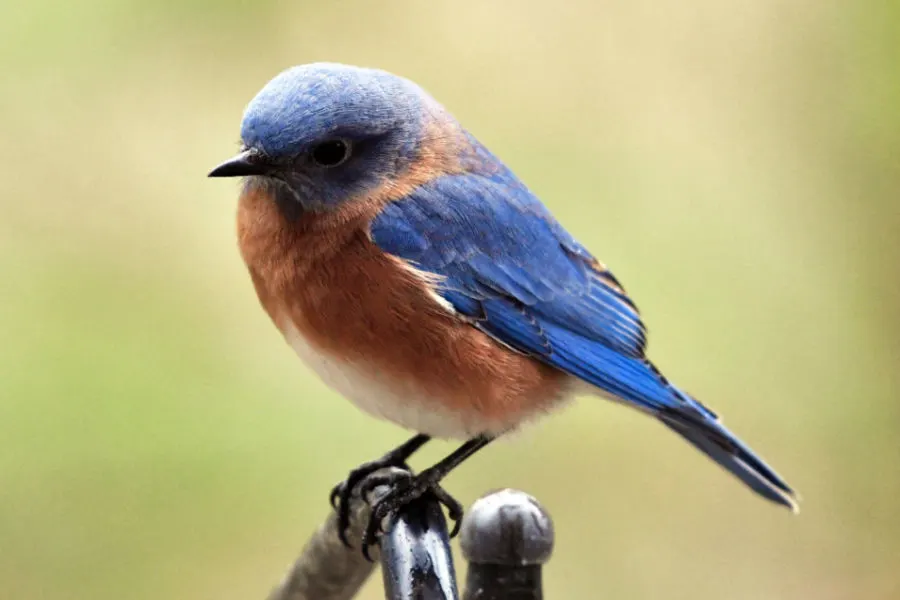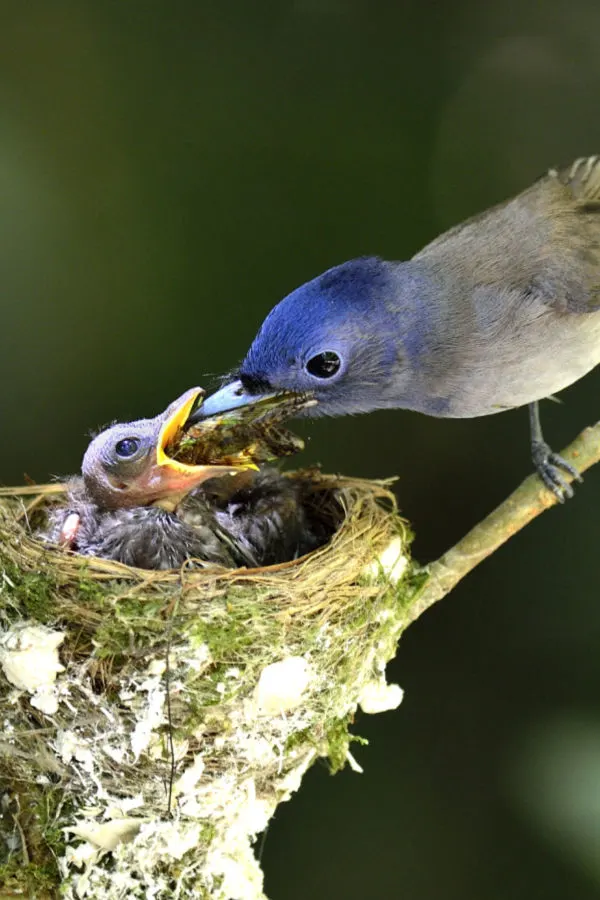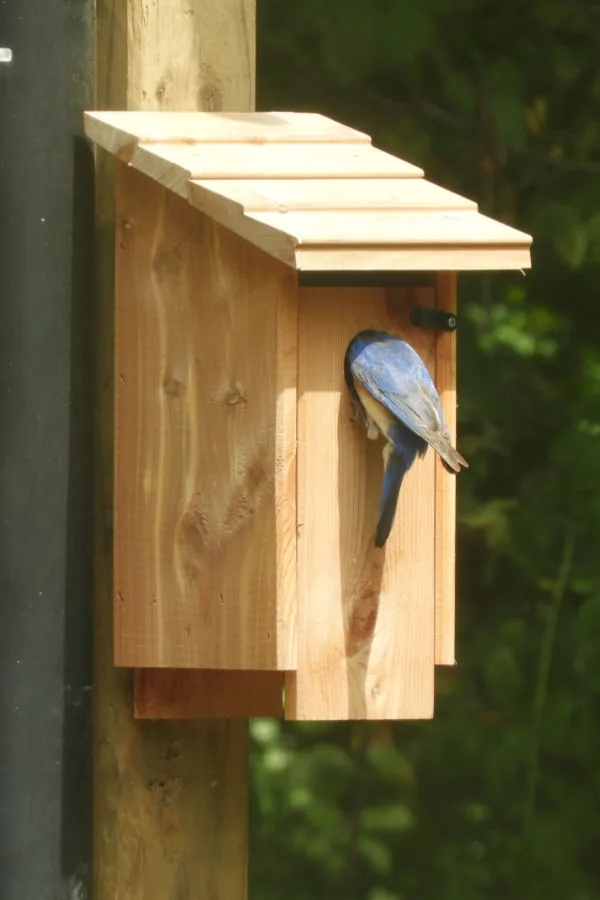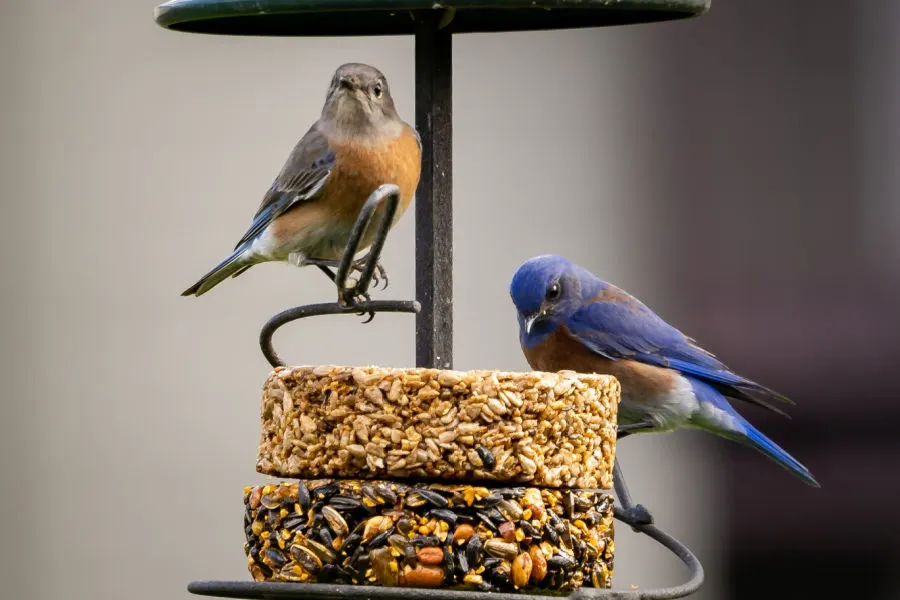One of the best ways you can help protect the plants in your garden and flowerbeds is to attract bluebirds to your landscape. Why? Because they are wonderful at keeping the pests that bother your plants completely under control!
Bluebirds are among the most beautiful to observe in nature. Male bluebirds have a cover of deep blue on both their backs and head, which stands in contrast to the reddish-brown tint to their breast. Females, although less showy, still maintain a gorgeous light blue tint to their tail and wings as well.
But beyond their beauty, bluebirds have a long and storied history with those that love to grow. For Native Americans, the birds returning to their area meant that spring was near and planting could commence. Bluebirds, much like cardinals, were also thought to represent a connection between the past and present of their ancestors.

Bluebirds & Insects
But perhaps more than anything else, Native American tribes knew the blue bird’s presence would help to keep insects from destroying their crops. A concept whose belief continues on with farmers and gardeners right up to the present day.
It is for that very reason you often see bluebird houses placed on fence poles all around the fields and large gardens of farmers to help provide a home for these beautiful birds. After all, if you can get the insect-devouring birds to take up residence nearby, the benefits they bring can only get better.
And it’s exactly why getting bluebirds to visit and stay in your yard can bring the same big benefits for you!
How To Attract Bluebirds To Your Yard
What Bluebirds Eat
So exactly what insects do bluebirds eat? The list is lengthy for sure. Although they will eat berries and small fruits on shrubs and trees, they prefer to dine on everything from grubs, mosquitoes, termites and spiders, to crickets, beetles, grasshoppers, ants and more.
Perhaps even more important, bluebirds also enjoy dining on insect larvae. That, of course, can be key in eliminating future generations of would-be pests in the process.

Having plenty of food sources on hand is certainly key in attracting and keeping bluebirds around. The good news for gardeners is that by simply planting a vegetable or flower garden, or having a landscape filled with trees, shrubs and perennials, you instantly create an environment that the insects they love to eat will inhabit.
But in addition to quality food sources, bluebirds are more prone to stick around areas where they can nest. For bluebirds, that means a safe and secure location where females can both lay their eggs and raise their young.
With both of those two key needs in mind, here is a look at how to best provide bluebirds with the quality food and housing that will have your backyard filled with avian pest-fighting help!
Providing Bluebirds A Home – How To Attract Bluebirds To Your Yard
Although bluebirds will build and live in natural nests created in trees and bushes, they are more than happy to take up residence in a ready made bird house. Especially when it is one that is safe and has been specially designed to fit their needs.

One thing is for sure, bluebird houses do not have to be complex. Bluebirds are cavity dwelling nesters that prefer to build their nest in a more confined space. Simple, salt-box style bird houses with a slanted roof (pictured above) are a tried and true design that have traditionally worked well for both enticing and getting bluebirds to nest. Product Affiliate Link: Cedar Bluebird Viewing House
Bluebird birdhouses can be found quite easily on-line or in stores for purchase. You can quite easily build you own with a few scraps of wood. But whether buying or building your own, there are a few things that go into making a bluebird house good for nesting.
What Makes A Great Bluebird House – How To Attract Bluebirds
To make a suitable home, bluebird house need to be able to keep water out, have good ventilation, and be able to drain off any moisture too. They also need to be secured high enough in the air to give the birds protection. Natural wood boxes are best, but if your bird house is painted, keep it in a lighter, reflective color to control heat.
Look for birdhouses that have an entrance hole between 1.5 and 2 inches in diameter. This will allow the bluebirds in, but not be so large to allow predators easy entrance. The entrance hole should be located at least five inches above the floor. The floor space should measure somewhere between 5 x 5 to 6 x 6 inches. Any more, and it will feel to big for them to nest.
Listen In Below To Our Podcast On The Best Seeds To Feed Birds!
Finally, do not place a perch outside below the hole. This only serves to allow predators an easier way to gain entry into the home. Don’t worry about your bluebirds, they will not use perches and do not need them for entry. But predators will!
Bird House Placement – How To Attract Bluebirds
Beyond the construction details of the bird house, where you place it is also a major key to its success in getting bluebirds to use it, and in keeping them safe when they do.
Place your bird house away from tree canopies and trees. Keeping them near trees gives predators easy access to climbing in and killing the birds. Instead, locate the bird house on a post or pole out in an open area.
Keep the bird house at least 6 feet off the ground. This too will help keep predators such as minks, raccoon and possum from trying to get in. To further help the cause, consider adding a small bird house / feeder pole baffle. This will help to keep animals out that attempt to climb up the pole.
Finally, get your bird house in place early! Putting up your birdhouse in late winter or fall gives birds plenty of advance time to scout out the home. Unfortunately, putting it up in the spring is often too late to have them commit to the new space.
Providing Water & Food Supplements – How To Attract Blue Birds
To help attract bluebirds, it is also important to make sure they have plenty of additional sources of food and water. Just as with all birds, bluebirds require water to keep them hydrated and energetic. Without a constant source of water, bluebirds will move on.

Small ponds or bird baths are wonderful for this purpose. Not only will bluebirds visit them time and time again, a nearby water source also makes it more likely for them to take up residence in a bluebird house. If you don’t have a water source, a small pail of water near their birdhouse can work.
Food For Bluebirds
Last but not least, although bluebirds love their insects, providing them with some additional tasty treats can improve your chances of keeping them around. One of the best ways to bring them in is by installing a bluebird mealworm feeder.
Bluebirds love mealworms, and will snack on them in quick fashion. They also happen to be wonderful for their diet and health. Bluebirds will also visit traditional bird feeders on a regular basis as well. Especially if you fill them with some of the softer bird feeds ( sunflower hearts, suet cakes, etc.) they enjoy.
Here is to attracting bluebirds to your landscape. And even more, having their help to stop insect and pest attacks on your crops and flowers! For more interesting articles on birds, be sure to check out our Birds, Bees & Insect category on the website.
Follow Our Facebook Page For Great Gardening Tips And Advice! This Is My Garden Facebook Page
This Is My Garden is a garden website created by gardeners, for gardeners. Jim and Mary Competti have been writing gardening, DIY and recipe articles and books and speaking for over 15 years from their 46 acre Ohio farm. They publish three articles every week, 52 weeks a year. Sign up today to follow via email, or follow along!
